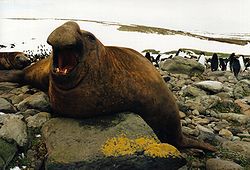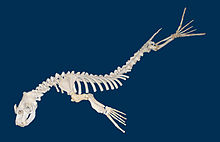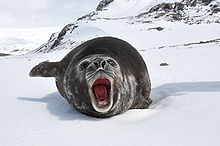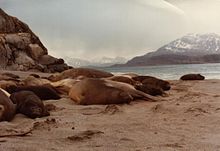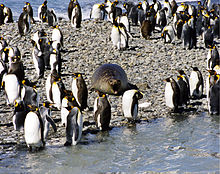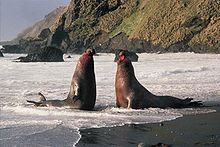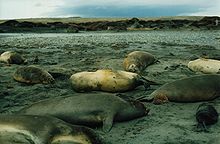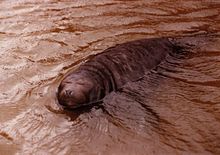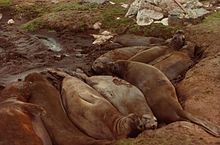- Southern elephant seal
-
Southern Elephant Seal Male (Bull) 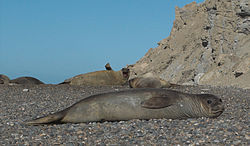
Female (Cow) Conservation status Scientific classification Kingdom: Animalia Phylum: Chordata Class: Mammalia Order: Carnivora Suborder: Pinnipedia Family: Phocidae Genus: Mirounga Species: M. leonina Binomial name Mirounga leonina
(Linnaeus, 1758)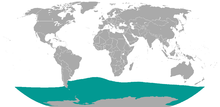
Southern Elephant Seal range The Southern Elephant Seal (Mirounga leonina) is one of the two extant species of elephant seal. It is both the most massive pinniped and member of the order Carnivora living today. The seal gets its name from its great size and the large proboscis of the adult males, which is used to make extraordinarily loud roaring noises, especially during the mating season.
Contents
Description
The Southern Elephant Seal is distinguished from the Northern Elephant Seal (which doesn't overlap in range with this species) by its greater body mass and a wider proboscis. This seals' size shows extreme sexual dimorphism, possibly the largest of any mammal, with the males typically five to six times heavier than the females.[2] While the females average 400 to 900 kilograms (880 to 2,000 lb) and 2.6 to 3 meters (8.5 to 9.8 ft) long, the bulls average 2,200 to 4,000 kilograms (4,900 to 8,800 lb) and 4.2 to 5 meters (14 to 16 ft) long.[3][4] The record-sized bull, shot in Possession Bay, South Georgia on February 28, 1913, measured 6.85 meters (22.5 ft) long and was estimated to weigh 5,000 kilograms (11,000 lb).[5][6] The maximum size of a female is 1,000 kilograms (2,200 lb) and 3.7 meters (12 ft). The eyes are large, round and black. The width of the eyes, and a high concentration of low light pigments, suggest that sight plays an important role in the capture of prey. Like all seals, elephant seals have hind limbs whose ends form the tail and tail fin. Each of the "feet" can deploy five long webbed fingers. This agile dual palm is used to propel water. The pectoral fins are used little while swimming. While the hind limbs are unfit for locomotion on land, elephant seals use their fins as support to propel their bodies. They are able to propel themselves quickly (as fast as 8 kilometres per hour or 5.0 miles per hour) in this way for short-distance travel, to return to water, to catch up with a female, or to chase an intruder.
Pups are born with fur and are completely black. Their coat is unsuited to water, but protects infants by insulating them from the cold air. The first moulting accompanies weaning. After moulting, the coats may turn grey and brown, depending on the thickness and moisture of hair. Among older males, the skin takes the form of a thick leather which is often scarred.
Like other seals, the vascular system of elephant seals is adapted to the cold; a mixture of small veins surround arteries, capturing heat from them. This structure is present in extremities such as the hind legs.
Range and population
The world population was estimated at 650,000 animals in the mid-1990s,[1] and was estimated in 2005 at between 664,000 and 740,000 animals.[7] Studies have shown the existence of three geographic subpopulations, one in each of the three oceans.
Tracking studies have indicated the routes traveled by elephant seals, demonstrating that their main feeding area is at the edge of the Antarctic continent. While elephant seals may come ashore in Antarctica occasionally to rest or to mate, they gather to breed in subantarctic locations.
The largest subpopulation is in the South Atlantic, with more than 400,000 individuals, including approximately 113,000 breeding females on South Georgia;[8] the other breeding colonies are located on the Falkland Islands and Valdes Peninsula in Argentina (the only continental breeding population).
The second subpopulation, in the south Indian Ocean, consist of up to 200,000 individuals, three-quarters of which breed in the Kerguelen Islands and the rest in the Crozet Islands, Marion and Prince Edward Islands, and Heard Island. Some individuals also breed on Amsterdam Island.
The third sub-population of about 75,000 seals is found in the subantarctic islands of the Pacific Ocean south of Tasmania and New Zealand, mainly Macquarie Island.
Colonies once existed in Tasmania, Saint Helena, and the Juan Fernández Islands off the coast of Chile. Sometimes individuals at the time of moulting have been found in South Africa or Australia. There have also been reports from time to time of animals lost on the shores of Mauritius. There are two reports from the Río Guayas estuary area in Ecuador.[7]
After the end of large scale seal hunting in the 19th century, the Southern Elephant Seal recovered to a sizable population in the 1950s; since then, there has been an unexplained decline in the subpopulations of the Indian Ocean and Pacific Ocean. The population now seems to be stable; the reasons for the fluctuation are unknown. Suggested explanations include a phenomenon of depression following a rapid demographic rebound that depletes vital resources, a change in climate, competition with other species whose numbers also varied, or even an adverse influence of scientific monitoring techniques.[citation needed]
Lifestyle
Social behavior and reproduction
Elephant seals are among the seals that can stay on land for the longest periods of time, as they can stay dry for several consecutive weeks each year. Males arrive in the colonies earlier than the females and fight for control of harems when they arrive.[9] Large body size confers advantages in fighting and the agonistic relationships of the bulls gives rise to a dominance hierarchy with access to harems and activity within harems, being determined by rank.[10] The dominant bulls or “harem masters” establish harems of several dozen females. The least successful males have no harems, but may try to copulate a harem male's females when the male is not looking.
An elephant seal must stay in his territory to defend it, which could mean months without eating, having to live on his blubber storage. Two fighting males use their weight and canine teeth against each other. The outcome is rarely fatal, and the defeated bull will flee; however, bulls can suffer severe tears and cuts. Some males can stay ashore for more than three months without food. Males commonly vocalize with a coughing roar that serves in both individual recognition and size assessment.[10] Conflicts between high ranking males are more often resolved with posturing and vocalizing than with physical contact.[10]
Generally, the pups are born rather quickly in the breeding season.[11] The newborn begins to suckle immediately. Lactation lasts an average of 23 days. Throughout this period, the female fasts. Newborns weigh about 40 kilograms (88 lb) at birth, and reach 120 to 130 kilograms (260 to 290 lb) by the time they are weaned. The mother loses significant weight during this time. Young seals that are weaned gather in nurseries until they lose their birth coat. They enter the water to practice swimming, generally starting their apprenticeship in estuaries or ponds. In summer, the elephant seals come ashore to moult. This sometimes happens directly after reproduction.
Feeding and diving
Satellite tracking revealed that the seals spend very little time on the surface—usually a few minutes for oxygen. They dive repeatedly, each time for more than twenty minutes, to hunt their prey—squid and fish— at depths of 400 to 1,000 meters (1,300 to 3,300 ft). The documented diving records for the seals are nearly two hours for the duration, and more than 1,400 meters (4,600 ft) in depth.
As far as duration, depth, and the sequence of dives, the Southern elephant seal is the best performing seal. In many regards, they exceed even most cetaceans. These capabilities result from non-standard physiological adaptations, common to marine mammals but particularly developed in elephant seals. The coping strategy is based on two pillars: increasing the storage of oxygen and reducing its consumption.
In the ocean, the seals apparently live alone. Most females mostly do only pelagic foraging' dives, while males do both pelagic and benthic foraging dives.[12] Individuals will return annually to the same hunting areas.
While hunting in the dark depths, it is partly thanks to the use of vision that the elephant seals seem to locate their prey; the bioluminescence of some prey animals can facilitate their capture. Elephant seals do not have a developed system of echolocation in the manner of cetaceans, but it is assumed that their vibrissae, which are sensitive to vibrations, play a role in search of food. When at the subantarctic or Antarctic coasts, the seals can also consume shellfish, nothothens,[13] Lanternfish,[13] krill, cephalopods[14] or even algae. Weaned pups may be predated by orcas and (rarely) by leopard seals, while juveniles may also fall prey to orcas.[15]
Conservation
After their near extinction due to hunting in the 19th century, the total population was estimated at between 664,000 and 740,000 animals in 2005,[7] but as of 2002 two of the three major populations were declining.[16] The reasons for this are unclear, but are thought to be related to the maldistribution and declining levels of the seal's primary food sources.[16] Most of their most important breeding sites are now protected by international treaty, as UNESCO World Heritage Sites, or by national legislation.
Minazo
One of the most famous southern elephant seals is Minazo, who lived in Japan's Enoshima Aquarium from when he was a half-year old until his death in 2005.[17] Minazo became popular for his signature bucket-holding, tongue-lolling pose. In 2006, Minazo was memorialized by the Japanese noise musician Masami Akita, also known as Merzbow, in a two-volume album[18][19] with artwork by Jenny Akita showing Minazo holding his beloved bucket.
In 2007, Minazo became the subject of an image macro similar to lolcat called lolrus. In his liner notes, Masami Akita suggests that Minazo's frequent and demanding performances left him exhausted, contributing ultimately to his death.[citation needed] Akita's intention in celebrating Minazo was to highlight the plight of captive animals used for performance before public audiences.[17] Minazo has also featured on several t-shirt designs.
See also
- Northern Elephant Seal
- Penelope seal
References
- ^ a b Campagna, C. (IUCN SSC Pinniped Specialist Group) (2008). Mirounga leonina. In: IUCN 2008. IUCN Red List of Threatened Species. Downloaded on 22 March 2009. Database entry includes a brief justification of why this species is of least concern
- ^ Perrin, William F.; Würsig, Bernd; Thewissen, J. G. M., eds (2008-11-24). "Earless Seals". Encyclopedia of Marine Mammals (2nd ed.). Burlington, Massachusetts: Academic Press. p. 346. ISBN 978-0-12-373553-9. http://books.google.com/?id=2rkHQpToi9sC&pg=PA23&lpg=PA23&dq=elephant+seal+greatest+sexual+dimorphism.
- ^ "Southern Elephant Seal". pinnipeds.org. Seal Conservation Society. http://www.pinnipeds.org/species/selephnt.htm.
- ^ Block, D.; Meyer, Philip; Myers, P. (2004). "Miroun". Animal Diversity Web. The Regents of the University of Michigan. http://animaldiversity.ummz.umich.edu/site/accounts/information/Mirounga_leonina.html. Retrieved September 11, 2010.
- ^ Wood, The Guinness Book of Animal Facts and Feats. Sterling Pub Co Inc (1983), ISBN 978-0-85112-235-9
- ^ Carwardine, Mark (2008). Animal Records. New York: Sterling. p. 61. ISBN 978-1-4027-5623-8. http://books.google.com/?id=T3FEKopUFkUC&pg=PA61&lpg=PA61&dq=-wikipedia+southern+elephant+seal+possession+bay+1913#v=onepage&q=-wikipedia%20southern%20elephant%20seal%20possession%20bay%201913&f=false.
- ^ a b c Alava, Juan José; Carvajal, Raúl (July/December 2005). "First records of elephant seals on the Guayaquil Gulf, Ecuador: on the occurrence of either a Mirounga leonina or M. angustirostris". Lat. Am. J. Aquat. Mamm. (Rio de Janeiro: Sociedade Latino-Americana de Especialistas em Mamíferos Aquáticos) 4 (2): 195–198. ISSN 1676-7497. http://solamac.org/LAJAM/4_2/pdf/Alava_Carvajal_2005.pdf.
- ^ Boyd, I.L.; Walker, T.R.; Poncet, J. (1996). Walton, David W. H.; Vaughan, Alan P. M.; Hulbe, Christina L.. eds. "Status of Southern Elephant seals at South Georgia". Antarctic Science 8 (3): 237–244. doi:10.1017/S0954102096000338. ISSN 0954-1020. http://journals.cambridge.org/download.php?file=%2FANS%2FANS8_03%2FS0954102096000338a.pdf&code=17cf656b0a4378796798fcc5c0bfb3b2.
- ^ Jones, E. (1981). "Age in relation to Breeding Status of the Male Southern Elephant Seal, Mirounga leonina (L.), at Macquarie Island." Australian Wildlife Research 8(2): 327–334.
- ^ a b c McCann T. S. (1981) "Aggression and sexual activity of male Southern elephant seals, Mirounga leonina", Journal of Zoology 195(3): 295–310,.
- ^ McCann, T. S. (1980). "Population structure and social organization of Southern Elephant Seals, Mirounga leonina (L.)." Biological Journal of the Linnean Society 14: 133–150.
- ^ MA Hindell, DJ Slip and HR Burton.(1991) "The Diving Behavior of Adult Male and Female Southern Elephant Seals, Mirounga-Leonina (Pinnipedia, Phocidae)", Australian Journal of Zoology 39(5) 595–619
- ^ a b G. Daneri and A. Carlini (2002) "Fish prey of southern elephant seals, Mirounga leonina, at King George Island", Polar Biology 25(10): 739–743
- ^ P. G. Rodhouse, T. R. Arnbom, M. A. Fedak, J. Yeatman, and A. W. A. Murray (1992) "Cephalopod prey of the southern elephant seal, Mirounga leonina L." Can. J. Zool. 70(5): 1007–1015.
- ^ [1][dead link]
- ^ a b Perrin, Wursig, and Thewissen, p. 371.
- ^ a b "Popular Enoshima aquarium seal dies after 101⁄2-year run". The Japan Times. October 7, 2005. http://search.japantimes.co.jp/cgi-bin/nn20051007b4.html.
- ^ Minazo Volume 1 at Allmusic
- ^ Minzao Volume 2 at Allmusic
Bibliography
- "Biology, threats and conservation status of the SUB-ANTARCTIC FUR SEAL AND SOUTHERN ELEPHANT SEAL in Australian waters". Australian Government, Department of the Environment and Heritage, Canberra. 2004. http://www.environment.gov.au/biodiversity/threatened/publications/recovery/seals-background/pubs/seals-background.pdf. Retrieved 15 August 2011.
- Block, D.; Meyer, Philip; Myers, P. (2004). "Mirounga leonina (Southern elephant seal)". Animal Diversity Web. The Regents of the University of Michigan. http://animaldiversity.ummz.umich.edu/site/accounts/information/Mirounga_leonina.html. Retrieved September 11, 2010.
- "Mirounga leonina". Integrated Taxonomic Information System. http://www.itis.gov/servlet/SingleRpt/SingleRpt?search_topic=TSN&search_value=180671. Retrieved 24 January 2006.
- "Mirounga leonina, Southern Elephant Seal". MarineBio. The MarineBio Conservation Society. http://marinebio.org/species.asp?id=296.
- Perrin, W.F.; Wursig, Bernd G.; and Thewissen, J.G.M. Encyclopedia of Marine Mammals. San Diego, Calif.: Academic Press, 2002.
- "Southern Elephant Seals". Wildlife of Antarctica. Antarctic Connection. http://www.antarcticconnection.com/antarctic/wildlife/SEALS/s_elephant.shtml.
- "Southern elephant seals biology". Elephant seals. Elephant Seal Research Group. http://www.eleseal.org/bio/biology.html. Retrieved September 11, 2010.
External links
 Media related to Mirounga leonina at Wikimedia Commons
Media related to Mirounga leonina at Wikimedia Commons- ARKive – images and movies of the southern elephant seal
- Southern Elephant Seal
- Elephant Seal Research Group
Categories:- IUCN Red List least concern species
- Animals described in 1758
- Fauna of Antarctica
- Fauna of Campbell Island, New Zealand
- Fauna of Heard Island and McDonald Islands
- Fauna of Macquarie Island
- Fauna of South Georgia and the South Sandwich Islands
- Fauna of the Crozet Islands
- Fauna of the Prince Edward Islands
- Île Amsterdam
- Mammals of Argentina
- Mammals of Chile
- Mammals of New South Wales
- Mammals of South Australia
- Mammals of Tasmania
- Mammals of Western Australia
- Mammals of Victoria (Australia)
- True seals
Wikimedia Foundation. 2010.

